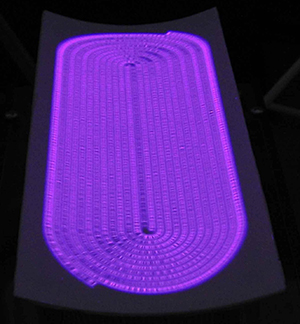
A new ‘diffuse coplanar surface barrier discharge’ (DCSBD) plasma source (pictured) that rapidly cleans flat polymer sheets in open-air conditions holds great promise for roll-to-roll manufacturing.
© 2013 Mirko Černak, Comenius University
Mass manufacture of photovoltaic materials is often achieved inexpensively by screen printing organic solar cells onto plastic sheets. The polymer known as poly(ethylene terephthalate), or PET, is a key part of the technology. Well known as the inexpensive plastic used to make soda bottles, PET has garnered increasing use as an optoelectronic substrate because of its strength and flexibility. But printing conductive solar-cell coatings onto PET is a challenge: it has a non-reactive surface and is frequently contaminated with static electric charges, which makes adhesion to other materials difficult.
Linda Wu from the A*STAR Singapore Institute of Manufacturing Technology and co-workers have now devised an innovative plasma treatment to ‘activate’ PET surfaces for improved bonding during roll-to-roll processing1. The team’s experiments with ‘diffuse coplanar surface barrier discharge’ (DCSBD) technology show that large-area PET sheets can be microscopically abraded and chemically modified to increase surface adhesion nearly instantaneously, thanks to plasma ions generated under open-air conditions.
Plasma treatments can quickly clean the surfaces of PET and other plastics2 without affecting their underlying properties or appearance. Normally, this technology requires clean rooms and vacuum chambers to turn noble gases into polymer-scrubbing plasma ions. The DCSBD technique, on the other hand, operates at atmospheric pressure and generates its plasma from ordinary air molecules. It achieves this through an inventive system of parallel, strip-like electrodes embedded inside an alumina ceramic plate. Applying a high-frequency, high-voltage electric field to these strips produces a thin and very uniform plasma field from ambient gases close to the ceramic plate (see image). The planar arrangement of this device makes it simple to treat only the top of the substrate using DCSBD in roll-to-roll lines.
When the researchers treated a PET substrate with a DCSBD plasma source, they saw immediate changes to the polymer surface: single-second plasma exposure times were sufficient to transform it from a water-repellent to a water-attractive surface. These modifications occurred uniformly over the entire PET substrate and provided improved adhesion power that lasted for more than 300 hours. X-ray and atomic force microscopy revealed that the short plasma bursts increased the proportion of surface polar groups and significantly enhanced microscale roughness.
Wu notes that the DCSBD technology is safe to touch (see video), easy to operate, and can be deployed in humid and dusty industrial environments. The team is currently investigating if the high power densities present in these atmospheric plasmas can be exploited for future nanomaterial deposition applications.
The A*STAR-affiliated researchers contributing to this research are from the Singapore Institute of Manufacturing Technology.
Being safe to touch is one of the benefits of DCSBD plasma technology.
© 2012 Mirko Černak, Comenius University



